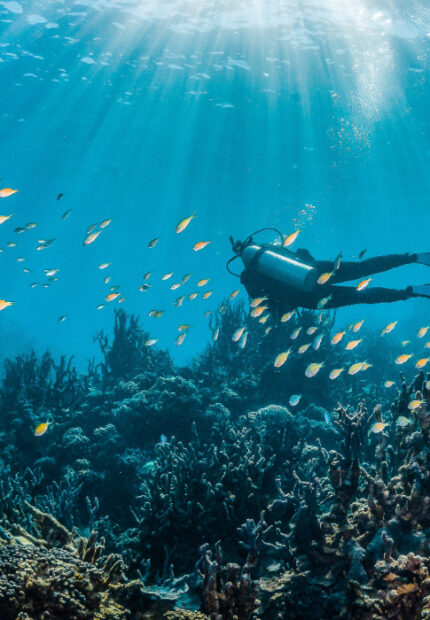
Is Diving in Silfra worth the money? Everything you need to know [2024]
Over 70% of Earth is underwater (they don’t call it the Blue Planet for nothing!) and since getting my PADI certification in Honduras, I’ve been obsessed with including at least a little bit of diving in all of my travel itineraries!
So when we visited Iceland, we just had to dive into the Silfra Fissure!
The Silfra Fissure in Iceland is one of the most incredible dive sites you will ever see! This crack in the Earth, which is being slowly ripped open by the movement of the North American and Eurasian tectonic plates, has incredible visibility and unique underwater scenery that is found nowhere else on Earth.
But is diving in Silfra worth it? Should you save the money? Or just snorkel instead? Let’s dive in and find out.
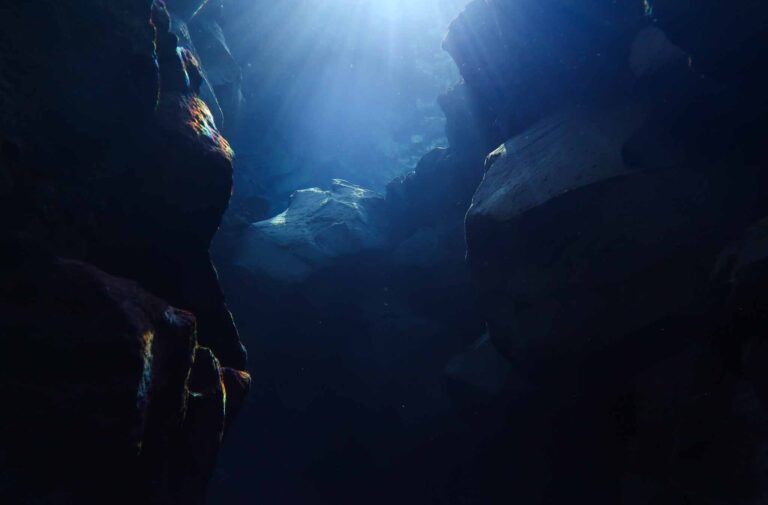
Underwater in the Silfra Fissure
WHAT IS THE SILFRA FISSURE?
The Silfra Fissure is a rift formed by the separation of the North American and Eurasian tectonic plates, located in Þingvellir National Park in Iceland. The plates are moving apart at a rapid 2cm per year (pretty quick when it comes to Geology).
The Silfra Fissue is a truly unique dive. It’s the only place in the world where you’re able to explore a gap between two continents. And swimming in some of the clearest water on Earth means the visibility is out of this world! Heck, you can stretch out your arms to PHYSICALLY TOUCH two of Earth’s largest continents at once.
Unlike many warm-water dive sites, there’s not much wildlife to see. Instead, it’s the geology of Silfra that shines. The underwater landscape, characterized by dramatic rock formations and an array of colours, creates an ethereal atmosphere. Seriously, it feels like you’re floating on another planet!
Plus, the bragging rights! Of all the dives I have done, this is the one dive that people ask me to tell them more about. It makes for a great ice-breaker (pun intended!).
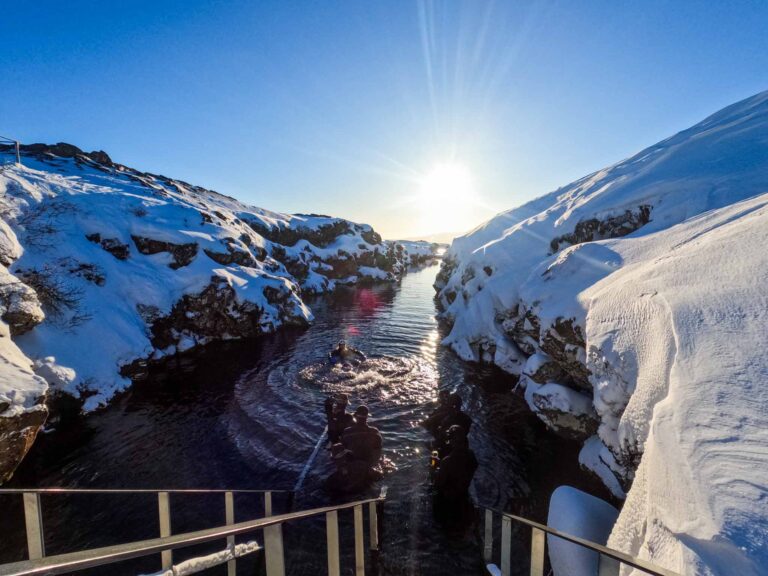
The Silfra fissure looks pretty unassuming from aboveland…
IS DIVING THE SILFRA FISSURE WORTH IT?
But is diving in Silfra worth it? It’s expensive, and there’s not a lot to see. What do you get for your money? Let’s go through it.
WHAT TO EXPECT: BEFORE YOU GO
You can’t dive in the Silfra Fissure by yourself. The numbers of divers each day are strictly regulated by Þingvellir National Park’s Rangers. This means that you’ll have to book your dive through one of the few companies that specialise in this fairly niche activity.
I did my dive with Dive.is and loved it. Their kit is top-notch, some of the best diving gear I’ve ever had the pleasure of borrowing. And their guides are super fun and make sure you have a great time. I’ve never felt so looked after!
Additionally, all divers require an Open Water AND dry suit certification (or have 10 logged dry-suit dives). The water in Silfra is really cold – between 2°C to 4°C (35°F to 39°F) – so you’ll need to wear a dry suit. This means you’ll be controlling your buoyancy in a completely different way – you inflate your dry suit rather than your BCD – which can be a bit disorienting the first time you try it.
You won’t be allowed to dive without dry-suit certification or equivalent experience. We were asked to show our certificates before they let us get geared up. You can do your dry suit certification in Iceland. But we recommend getting it in your home country, where it’ll probably be cheaper!
WHAT TO EXPECT: THE DIVE
Once you’ve shown your certifications, you’ll get geared up. The company provides all of the essential diving gear, including a dry suit that will keep you toasty warm in the freezing water.
We won’t prattle on about wearing a dry suit and what to expect. If you’re diving, you should be familiar with how a dry suit feels and how to use it (or booking onto a course to learn this before your Silfra dive!).
Then, it’s a 100m walk to the entry point. You’ll jump in the water – yes it’s bloody cold but after a few seconds, the shock wears off and your neoprene hood and gloves start doing their job. After a quick buoyancy check, your certified PADI dive guide or divemaster will guide you around the Silfra Fissure.
Most dive packages in the Silfra Fissure include one dive, which lasts around 30 to 40 minutes. You use your air up faster when it’s cold, so the temperature limits how long you can stay underwater! The maximum depth is 18 metres.
You’ll swim through four distinct parts of Silfra, beginning with the narrowest section first (this is the part where you can touch both continents at the same time). As the Silfra fissure widens you’ll swim through ‘Silfra Hall’ and into the majestic ‘Silfra Cathedral’ – the deepest point. Then, it’s a chilled-out swim back through the relaxed, endless visibility of ‘Silfra Lagoon’.
The water is very cold. But it’s nothing to worry about. Your dry suit and base layer will keep you warm and dry. On our trip to Iceland in winter, it was still warmer than the outside air temperature!
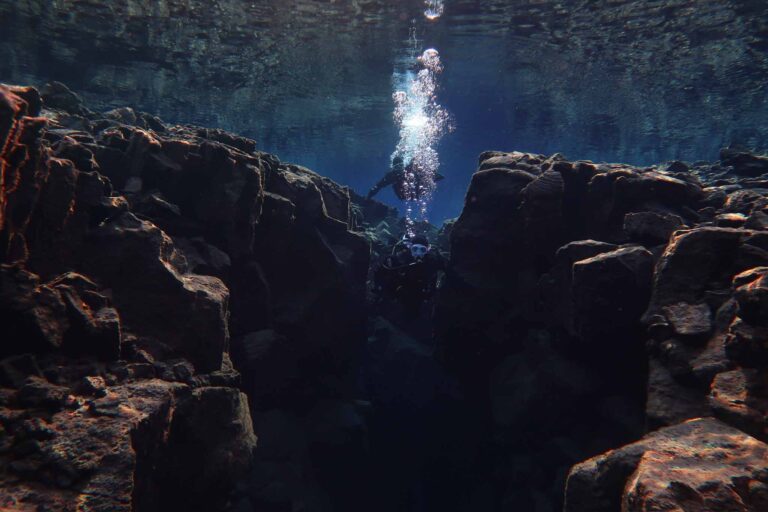
…but underwater it’s magical
IS DIVING THE SILFRA FISSURE WORTH IT? HOW MUCH DOES IT COST?
The cost of diving in Silfra can vary, depending on which dive operator you pick, the type of dive package, and what time of day you go. Our dive with dive.is cost 31.990 ISK (£183 GBP / $230 USD). This was the cheapest option we could find.
THIS INCLUDES:
- Equipment rental
- A seriously luxurious (and very expensive) drysuit
- A fleece jumpsuit to go underneath for warmth
- Neoprene gloves, booties, and hood
- Snorkel and fins
- BCD
- 1 tank of air
- Dive guide or divemaster to lead the guide (+ a whole backup team to take care of you at the vans!)
- Hot chocolate and cookies to warm up after the dive
THIS DOES NOT INCLUDE:
- Transport to/from Silfra (can be included for extra cost – prices start at 40.490 ISK incl. Return transport)
- Tips. Not expected but appreciated!
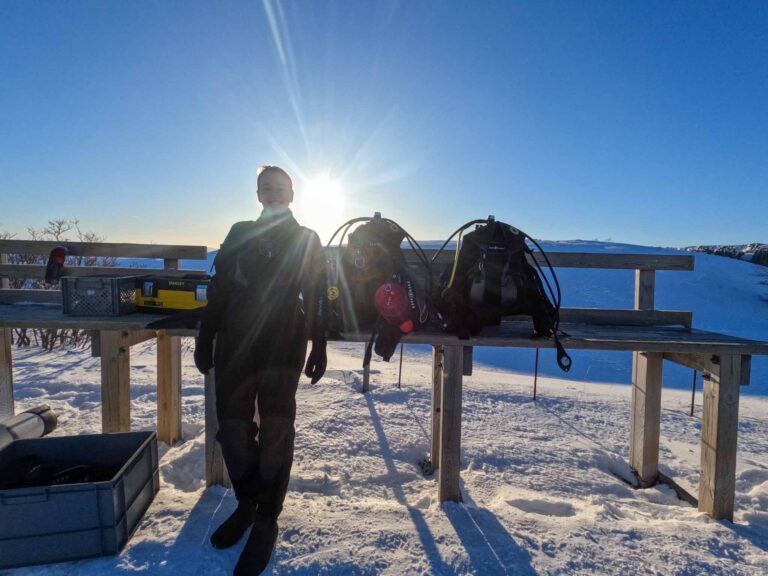
Getting geared up to dive in the Silfra Fissure: Totally worth it!
WHY IS DIVING IN SILFRA SO EXPENSIVE?
Let’s face it. Diving isn’t a budget-friendly activity in most places really.
And Iceland has a big reputation for being a very expensive country. Iceland is super remote, which means almost everything has to be imported. Fresh fruit, vegetables, fuel for vehicles… it all has to come by boat! This, coupled with a small population and high standards of living, contributes to much higher prices for goods and services.
When you snorkel or dive in Silfra, you need to pay your guides enough to afford the high cost of living in Iceland. After all, your dive guides have to pay higher prices for basic life necessities.
Diving in Silfra is also a super niche activity. It takes a lot of people to organise these dives for not a lot of tourists. Add to that the price of the gear and gear maintenance (the gear you borrow costs thousands of pounds, euros, or dollars) and you’re looking at an already-expensive activity… made even more costly.
We know it’s expensive. But if diving in Silfra is something you really want to do, there are ways to reduce your overall spending in Iceland elsewhere and balance the budget a bit!
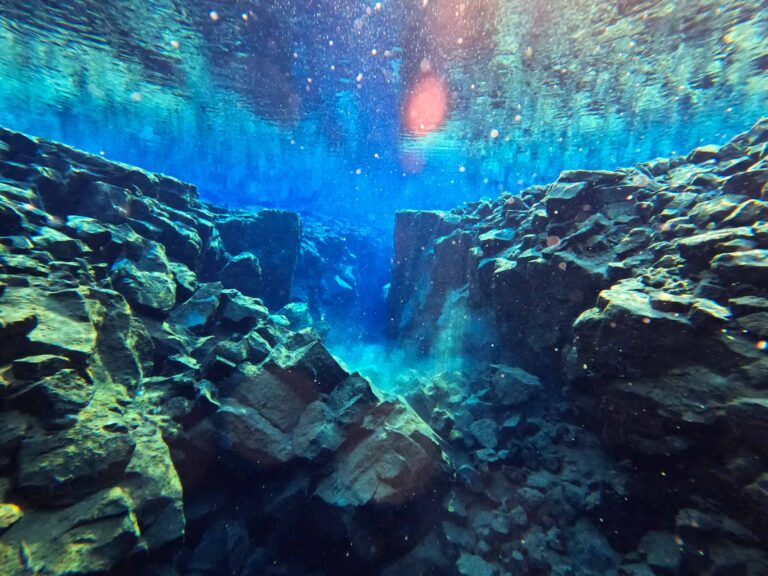
Gorgeous mirror effects underwater
IS DIVING SILFRA WORTH IT? OUR EXPERIENCE:
Although I pride myself on being a budget-savvy traveller, the budget seems to fly out of the window when it comes to a few things. Diving is one of them.
Diving in the Silfra was totally worth it for me! It was one of the most unique dives I’ve ever done. Floating between two continents feels incredible.
From the moment I descended into the crystal-clear waters, I was mesmerized by the visibility – it’s so clear that it feels like you’re suspended in air, like you’re floating in liquid space. The only thing that reminded me that I was underwater was the steady flow of bubbles coming out of my regulator.
Navigating through the narrow crevices and gliding past ancient rock formations was like exploring an alien landscape. As a bit of a geology nerd, I found the rock formations super fascinating. It’s totally eerie and utterly still, void of life.
We were also very lucky with the weather – the sun sent rainbows dancing around underwater wherever you looked.
But as with anything, it’s important to set your expectations. Silfra has no fish, no coral, no vegetation of any kind. But that’s OK. I didn’t go diving in Iceland to see fish (that’s not to say I didn’t miss the wildlife a bit). At some points, the dive is also so shallow that you might as well be snorkelling as you’re only about 1m under

Rainbows dancing on the riverbed
DIVING IN SILFRA: WHAT’S HOT AND WHAT’S NOT:
WHAT’S HOT
- Super cool geological formations
- Incredible visibility
- The only place in the world where you can dive between tectonic plates
- Bragging rights – not many people have their qualifications lined up before they choose to dive Silfra
- A very unique dive that you won’t really find elsewhere
WHAT’S NOT
- The water temperature (I joke, it’s not that bad)
- The price – we can’t lie, it’s expensive!
- You need a dry suit qualification. If you won’t use this again, it doubles the price of a single dive!
- There isn’t any wildlife to spot
- The dive is quite short, it only lasts around 30 minutes
SO, IS DIVING IN SILFRA WORTH THE MONEY?
In my opinion, diving in Silfra is an experience unlike any other and is absolutely worth the money.
There’s something about freshwater diving that I love. The water is soft and wonderfully clear. The only dive that I’ve had almost equally good visibility was cenote diving in Mexico.
Although there wasn’t much wildlife to look at, the incredible rock formations more than made up for it. Diving in Iceland’s off-season meant that we had the fissure all to ourselves for the most part. It was a really nice and intimate dive.
And whilst the price was expensive, the service was top-notch. The equipment we borrowed was some of the best I’ve had the pleasure of diving in. And the team at Dive.is, did a great job at looking after us (seriously, I didn’t even have to dress myself for the dive!). Shoutout to Ody for being a super fun guide and throwing in some free photos for us at the end!
Overall, if you have the money and the qualifications, I’d say go for it! If you’re worried about the price, check out our money-saving tips for Iceland and see if you can cut costs elsewhere.

Underwater in the Silfra Fissure
6 TIPS TO ENJOY YOUR DIVE IN SILFRA
So, you’re still reading! We convinced you to dive in the Silfra Fissure! Good for you. You won’t regret it. Diving in Silfra is an experience that stays with you forever.
Here are our top tips to make sure you have the best time!
1.
Bring a spare change of clothes. Sometimes (very rarely) you get wet in a dry suit, either due to the suit itself, or user error. We stayed dry in Silfra thanks to the high-quality kit provided by dive.is.
2.
Bring the right base layers. Unlike wetsuit dives, you don’t need to wear swimwear. Instead, bring some fleece or wool thermals to wear under your dry suit. We swam in merino wool leggings and a long-sleeved shirt as a base layer, with the fleecy jumpsuit provided, then the dry suit on top.
3.
Take a GoPro if you have one! Your guide will snap photos of you and get you to ‘really work that camera’ (yep, that’s what they told the snorkellers…). But at the end, they will try to sell the photos for 3.000 ISK (~£15 GBP / $18 USD) – expensive!
We got lucky! We were the only two on the dive and didn’t need professional photos. But our dive master took along the company camera to get some shots for himself. He then ended up emailing us them for free because he was in a good mood, and it was his last dive of the season. Score!
4.
Trust your dive guide. Dry suits are extra buoyant so you’ll need extra weights. Trust your divemaster, they do this every day.
5.
Inflate your drysuit on land. When you get out, inflate your dry suit. The extra layer of air will keep you warm as you walk back to the car park to get changed.
6.
Look after the gear. Diving in cold weather means you need to use your equipment differently. For example, you should never purge air through your regulator as parts can instantly freeze up and damage it.
LIKE IT? PIN IT!
SAVE THIS POST TO YOUR PINTEREST BOARD TO COME BACK LATER

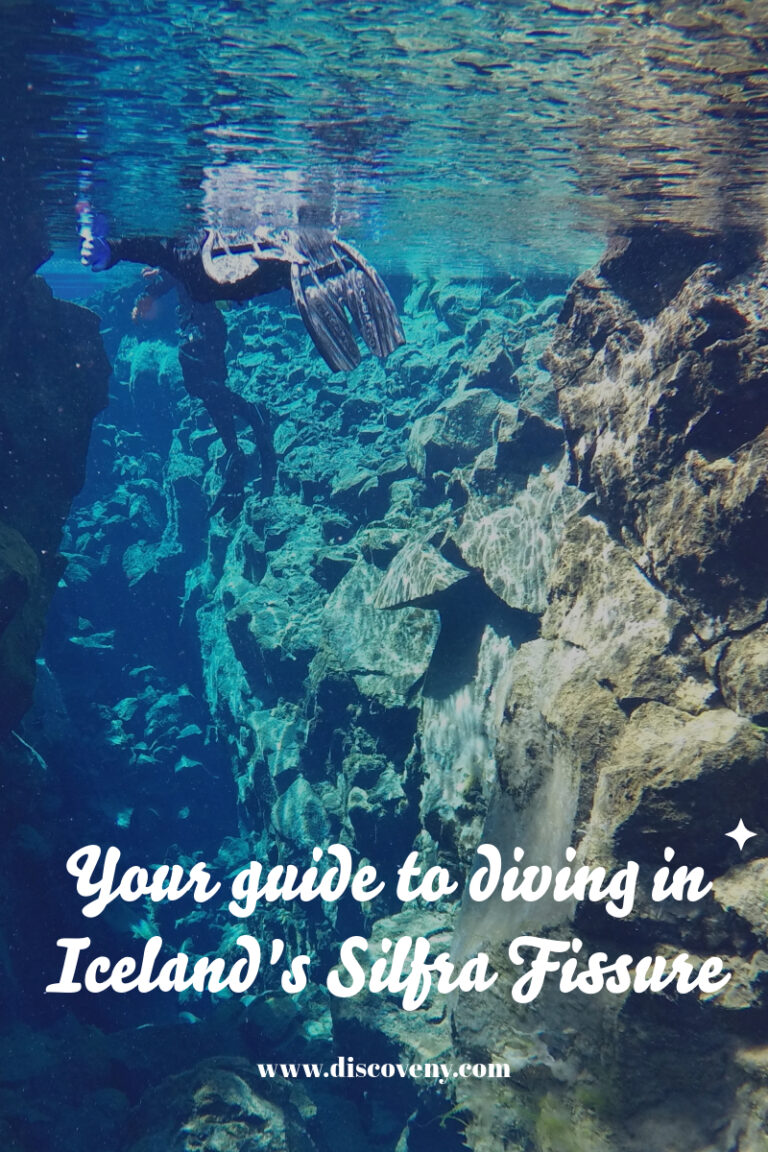
Follow our daily adventures on Facebook and Instagram
Disclaimer: The information and advice provided in this blog are the author’s opinions and based on their personal experiences. All information was accurate at the time of writing. However, things can change quickly, so always double-check current conditions and guidelines before setting out. Remember, your travels and safety are your own responsibility, and this blog can not be held responsible for anything that might happen on your adventures! Always exercise caution and good judgment. Oh, and don’t forget to get travel insurance! Happy travels!
This post may contain affiliate links (yay for transparency!) This means that I will earn a small commission, at no additional cost to you, if you click the link and choose to buy the product. I only link to stuff I have personally bought and found useful and never endorse crap. Your support helps keep the site going, thank you!
Alice
Alice is a UK travel blogger who advocates sustainable travel and being more eco-conscious on a budget. She loves coffee, her houseplants and summiting mountains.
You May Also Like

The Ultimate Guide to Diving in Caye Caulker, Belize [2024]
April 27, 2024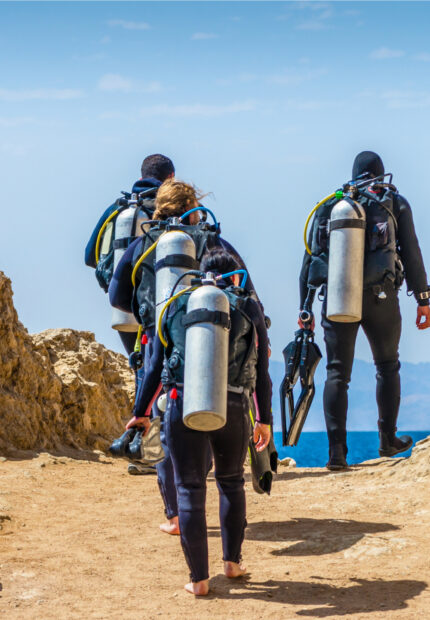
Sharm el Sheikh VS Dahab: Where’s best in Egypt for your Red Sea diving?
June 22, 2024